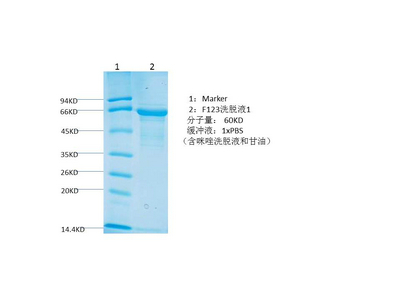Caspase 3 protein
- Catalog No.:YD0020
- Applications:WB;SDS-PAGE
- Reactivity:Human
- Gene Name:
- CASP3
- Protein Name:
- Caspase3
- Sequence:
- Amino acid: 1-113, with his-MBP tag.
- Human Gene Id:
- 836
- Human Swiss Prot No:
- P42574
- Mouse Swiss Prot No:
- P70677
- Formulation:
- Liquid in PBS
- Source:
- E.coli
- Dilution:
- WB 1:500-2000
- Concentration:
- SDS-PAGE >90%
- Storage Stability:
- -20°C/6 month,-80°C for long storage
- Other Name:
- Caspase-3 (CASP-3) (EC 3.4.22.56) (Apopain) (Cysteine protease CPP32) (CPP-32) (Protein Yama) (SREBP cleavage activity 1) (SCA-1) [Cleaved into: Caspase-3 subunit p17;Caspase-3 subunit p12]
- Background:
- catalytic activity:Strict requirement for an Asp residue at positions P1 and P4. It has a preferred cleavage sequence of Asp-Xaa-Xaa-Asp-|- with a hydrophobic amino-acid residue at P2 and a hydrophilic amino-acid residue at P3, although Val or Ala are also accepted at this position.,enzyme regulation:Inhibited by isatin sulfonamides.,function:Involved in the activation cascade of caspases responsible for apoptosis execution. At the onset of apoptosis it proteolytically cleaves poly(ADP-ribose) polymerase (PARP) at a '216-Asp-|-Gly-217' bond. Cleaves and activates sterol regulatory element binding proteins (SREBPs) between the basic helix-loop-helix leucine zipper domain and the membrane attachment domain. Cleaves and activates caspase-6, -7 and -9. Involved in the cleavage of huntingtin.,PTM:Cleavage by granzyme B, caspase-6, caspase-8 and caspase-10 generates the two active subunits. Additional processing of the propeptides is likely due to the autocatalytic activity of the activated protease. Active heterodimers between the small subunit of caspase-7 protease and the large subunit of caspase-3 also occur and vice versa.,PTM:S-nitrosylated on its catalytic site cysteine in unstimulated human cell lines and denitrosylated upon activation of the Fas apoptotic pathway, associated with an increase in intracellular caspase activity. Fas therefore activates caspase-3 not only by inducing the cleavage of the caspase zymogen to its active subunits, but also by stimulating the denitrosylation of its active site thiol.,similarity:Belongs to the peptidase C14A family.,subunit:Heterotetramer that consists of two anti-parallel arranged heterodimers, each one formed by a 17 kDa (p17) and a 12 kDa (p12) subunit.,tissue specificity:Highly expressed in lung, spleen, heart, liver and kidney. Moderate levels in brain and skeletal muscle, and low in testis. Also found in many cell lines, highest expression in cells of the immune system.,
- Function:
- regulation of cyclin-dependent protein kinase activity, DNA catabolic process, endonucleolytic, leukocyte homeostasis,B cell homeostasis, release of cytochrome c from mitochondria, lymphocyte homeostasis, negative regulation of immune system process, regulation of leukocyte activation, negative regulation of leukocyte activation, DNA metabolic process, DNA catabolic process, DNA fragmentation involved in apoptosis, negative regulation of protein kinase activity, proteolysis, apoptosis, induction of apoptosis, cell structure disassembly during apoptosis, response to DNA damage stimulus, nucleus organization, mitochondrion organization, ectoderm development, heart development,sensory perception, sensory perception of sound, cell death, negative regulation of cell proliferation, epidermis development, induction of apoptosis by extracellular signals, induction of apoptosis by intracellular s
- Subcellular Location:
- Cytoplasm.
- Expression:
- Highly expressed in lung, spleen, heart, liver and kidney. Moderate levels in brain and skeletal muscle, and low in testis. Also found in many cell lines, highest expression in cells of the immune system.
- June 19-2018
- WESTERN IMMUNOBLOTTING PROTOCOL
- June 19-2018
- IMMUNOHISTOCHEMISTRY-PARAFFIN PROTOCOL
- June 19-2018
- IMMUNOFLUORESCENCE PROTOCOL
- September 08-2020
- FLOW-CYTOMEYRT-PROTOCOL
- May 20-2022
- Cell-Based ELISA│解您多样本WB检测之困扰
- July 13-2018
- CELL-BASED-ELISA-PROTOCOL-FOR-ACETYL-PROTEIN
- July 13-2018
- CELL-BASED-ELISA-PROTOCOL-FOR-PHOSPHO-PROTEIN
- July 13-2018
- Antibody-FAQs
- Products Images




